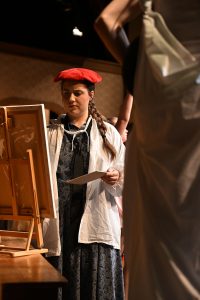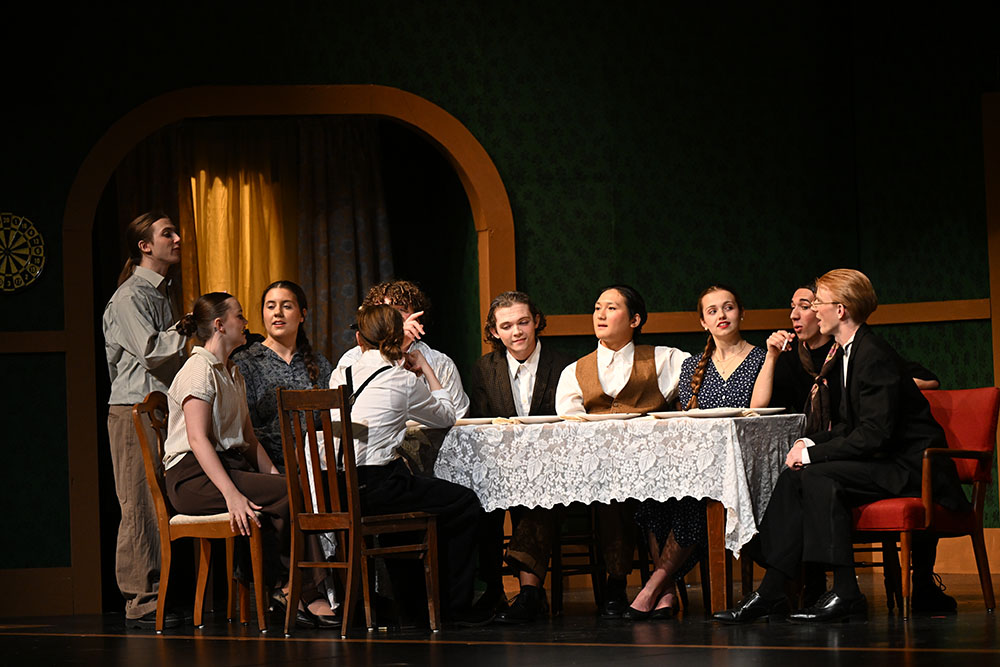The production “You Can’t Take It With You” wasn’t just another fall play. This year, it was a race against time. Theater magic usually takes six to eight weeks to build, but this year, the cast and crew had just over four. With the clock ticking, every rehearsal, every line and every set piece mattered more than ever.
After an unprecedented audition turnout and a tight rehearsal schedule, director Kathryn Frankforter knew they would have to adapt and work quickly to be prepared for opening night. The shortened timeline forced everyone involved with the play to “up their game”, according to Frankforter. However, this pressure led to a collaborative and energized production experience.
Auditions were the first indicator that this play would be different from others that Frankforter has directed. This year, over 40 talented and hopeful students walked into the audition room. That turnout is more than Frankforter and Carly Brittenham (11), the president of Drama Club, had ever seen before.
Even though this brought a feeling of optimism for Frankforter and Brittenham for the future of theater, a growing department, it also meant having to cut down almost half the auditioners. There were only 17 spots available.
“We really wanted to find the group that was going to build off of each other, that was going to listen to each other, and work and react to each other,” Frankforter said.
Since this production’s plot is centered around family, it was important that the actors had the chemistry to build a connection and bounce off each other’s energy.
On the flip side, students felt an immense amount of pressure to stand out.
“It was, I think, a little bit stressful for upperclassmen, because there’s kind of an assumption that you’ll just make it into the shows the older you get, which is not always true,” Brittenham said. “So I think everybody started to work a little harder to prepare for auditions.”
Even though the large audition turnout brought stress to many, it made every single auditioner give it their all and truly earn their role.
As they transitioned from auditions to rehearsals, the schedule was finalized and released. The cast soon realized that rather than being given six weeks to put on the fall play, they would only be granted four and a half.
This meant that the crew would have less time to build a set from scratch, the actors needed to have their lines memorized sooner and generally, the whole production would have to move at a quicker pace.
However, this timeframe didn’t disrupt the flow of the production, nor did it make it stressful.
“[The play is] a comedy. It’s hard to do a comedy in an environment that’s really stressful,” Frankforter said. “So we’re enjoying our time together while still getting through what we need to get through in order to have a successful show.”
This smooth transition was made possible by the intricate planning done on Frankforter’s behalf. If she hadn’t chosen this production, which had a smaller cast and needed only one set, people wouldn’t have been able to adjust to the fast-paced environment.
Even though this choice of production corresponded well with the schedule, the style of it is different from what the theater students have experienced before.
The fall play is the 1936 comedy which is about the two lovers, Alice Sycamore and Tony Kirby, who come from two different family dynamics. When the free-spirited Sycamores and the traditional Kirbys meet for the first time, everything goes awry.
The play is a classic, meaning that the time period is drastically different from today. At first, the cast found it difficult to mold into the characters and portray them in a realistic way.
Brittenham, who plays Penelope, experienced this challenge.
“Trying to figure out a character voice that feels natural [has been difficult],” Brittenham said. “The characterization is different just because people act differently now than they did back then.”
Despite this challenge, Frankforter never doubted that the students wouldn’t be able to adjust to the new style, because they are what she would call “character actors”. They are versatile, meaning that they can fit into any role or character and adjust to any emotion.
“We have students that can pretty much be chameleons,” Frankforter said. “Our rehearsal times have been spent collaborating on funny bits that they could do in their roles or character moments that are going to deepen these characters and make them feel more realistic.”
Brittenham and her fellow cast are gifted actors, but what maes their characters pop on stage is the prep done behind the scenes.
For Brittenham, her priority has always been towards improving her acting abilities, and in this play, finding the “voice” and emotion of her character is what mattered the most. Over the past few years, she figured out a trick to it all. Find a person in your life that reminds you of the character you’re playing.
“Penelope reminds me of my grandma a lot, so I try to act like my grandma when I’m playing her,” Brittenham said.
Brittenham has always been able to bounce back, just like the rest of the cast, and the work they’ve put in behind the scenes has never gone unnoticed.
Frankforter noticed. That’s why she chose this play. They were the perfect people for it.
“If we had a different group, I don’t know if we would have chosen this particular show. It just matched their energy the most,” Frankforter said.
At first, the time frame and small cast were what drew Franforter to this play, but what finalized her decision was the students.
It has become eminently clear that this fall production has been exposed to new experiences that they hadn’t encountered before, but it has only driven the actors and this production to success.

Photo By: Michael Reinmiller



